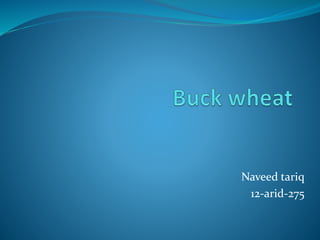
Buck wheat
- 2. BUCK WHEAT Botanical name :Fagopyrum esculentum Family: polygonaceae Crop : Di-cot, annual
- 3. Common buckwheat (Fagopyrum esculentum) is thought to have originated in central and western China from a wild Asian species Fagropyrum cymosum. It has been cultivated in China for over 1,000 years, and was brought to Europe during the Middle Ages.
- 4. The Scots coined the word "buckwheat" from two Anglo-Saxon terms, boc(beech) and whoet(wheat). The word beech was used since the fruit of the plant was similar to that of beechnut. It was called wheat because the grain of buckwheat was used in the same way as wheat. This term is somewhat ironic since buckwheat does not belong to the grass family and is not considered a "true" cereal
- 5. World acreage of buckwheat has been as high as 5 million acres (2 million hectares). Producers include the former Soviet Union, China, Brazil, Poland, France, Japan, United States, South Africa and Australia. The former Soviet Union (54 per cent) and China (38 per cent) make up the largest percentage of world production.
- 6. Economic importance Buckwheat (Fagopyrum esculentum) is a plant cultivated for its grain-like seeds, and also used as a cover crop. Its seeds are eaten and rich in complex carbohydrates, it is referred to as a pseudocereal.
- 7. Nutritional valueAmount Per 100 grams Calories 343 Total Fat 3.4 g 5% Saturated fat 0.7 g 3% Polyunsaturated fat 1 g Monounsaturated fat 1 g Cholesterol 0 mg 0% Sodium 1 mg 0% Potassium 460 mg 13% Total Carbohydrate 72 g 24% Dietary fiber 10 g 40% Protein 13 g 26%
- 8. Nutritional value Calcium 1% Iron 12% Vitamin B-6 10% Vitamin B-1 20% Magnesium 57% *Per cent Daily Values are based on a 2,000 calorie diet. Your daily values may be higher or lower depending on your calorie needs.
- 9. Buckwheat thrives in cool, moist climates. It is not frost tolerant. Because of its short growing period. High temperatures and dry conditions during flowering may cause some flower blast and lower yields. Cool evening temperatures and high humidity favour buckwheat growth. Growers in areas with frequent heavy rain and strong wind should consider the risks in growing buckwheat. It is very susceptible to lodging because of its hollow stem and is easily flattened by high wind and heavy rain.
- 10. Buckwheat can be grown on a wide range of soil types, but it is best suited to light and medium-textured soils, such as sandy loam, loam and silt loam. Clay soils and highly fertile soils should be avoided. Buckwheat is as acid tolerant as oat or potato. Liming soils above a pH of five should not be necessary.
- 11. General recommendations for added nutrients are as follows: (22 - 45 kg/ha) nitrogen, depending on whether the crop is planted on summer fallow, pulse stubble or cereal stubble. Normal rates for phosphate range from (30 - 45 kg/ha). Potash is generally recommended if the crop is grown on sandy loam soils. The suggested rate for potash in these cases would be (35 - 70 kg/ha). When sulphur is required (15 kg/ha). No more than 5 lb/ac (5.6 kg/ha) nitrogen and 20 lb/ac (22 kg/ha) phosphate should be applied with the seed.
- 12. seed Buckwheat has triangular seed The name 'buckwheat' or 'beech wheat' comes from its triangular seeds, which resemble the much larger seeds of the beech nut from the beech tree, and the fact that it is used like wheat.
- 13. Root system The plant has a branching root system with one primary root that reaches deeply into the moist soil
- 14. The tall erect plant can grow from 2 to 5 ft. (.6 - 1.5 m) in height and can produce several branches.Stems are hollow and the plant is very prone to lodging. Stems vary in colour from green to red and brown at maturity.
- 15. Food for humans, feed for livestock, a honey crop, smother and green manure crop. Buckwheat grain is of lower quality than cereal grains when used for livestock feeds and is usually fed in combination with barley, oats or corn. Buckwheat has also been used as a smother crop for controlling weeds such as quack grass, Canada thistle, sow thistle, leafy spurge and Russian knapweed.
- 17. Date: 27-8-15 Controlled conditions: Duration: For a week light: 5(ls) humidity: 78% Irrigation: with one day interval NO. of seed planted : 64 NO. of seed germinated: 44 Germination percentage: 69%
- 18. Date: 7-9-15 No. of pots:10 No. of plant:24
- 19. Date: 28-9-15 No. of flower per bunch:10-12 Rate of seed set: 3- 4/bunch Seed setting start:10-10-15
- 20. Buckwheat has an indeterminate growth habit. The plant matures from the bottom upwards, flowering until cut or killed by a frost. At harvest, mature seed, immature seed and a few flowers will be present. A grower must determine when to start harvest before losses occur due to shattering. Harvest should begin when 75 per cent of the seeds have reached physiological maturity, and the plants have lost a majority of their leaves.
- 21. Diseases There are few reports of diseases in buckwheat. Leaf spot caused by a fungus called Ramilaria can occur. Rhizoctonia (root rot), downy mildew and aster yellows have also been found. None of these diseases is of any economic importance. Insects Japanese beetles, aphids, cutworms and wireworms have all been reported in buckwheat. Japanese beetles do the most damage, attacking the flower head, and on occasion, can cause major economic loss.